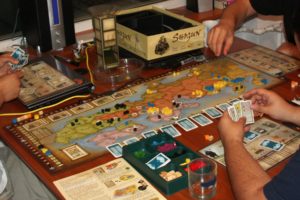 Whether you’re teaching a new game or trying to introduce one of your favorites to a new group of people, the ability to teach game play in a clear and concise way is an important skill. It can also be an intimidating element of the hobby when you aren’t comfortable doing it. A bad rules explanation can make even the best games a miserable experience – so how can someone just getting started teach rules in a way that gets people excited about playing with them? I’ve taught countless games by now, but I’ve also been taught just as many. I’ve seen a number of different approaches, but there are things you’ll need to do to be effective.
Whether you’re teaching a new game or trying to introduce one of your favorites to a new group of people, the ability to teach game play in a clear and concise way is an important skill. It can also be an intimidating element of the hobby when you aren’t comfortable doing it. A bad rules explanation can make even the best games a miserable experience – so how can someone just getting started teach rules in a way that gets people excited about playing with them? I’ve taught countless games by now, but I’ve also been taught just as many. I’ve seen a number of different approaches, but there are things you’ll need to do to be effective.
You Can’t Teach What You Don’t Know
Sure, it’s possible to pick up a box and wade through the rules together. If you just came from the store and can’t wait to try out your new game, you can make it work. The problem with that, though, is that You can spend a half hour face down in a rulebook before you’ve even made a single play. Before you say word one, you need to have done your homework. Read the rules a couple of times. Figure out the highlights and most important information, and prepare what you want to communicate to the other players.
In an ideal world, all of your players will do their homework and know the rules already. But we don’t live in an ideal world. Even if you announce the game ahead of time and send a link to a rules explanations over at Watch It Played, you’ll have people at your table who don’t know anything about the game you’re playing. You can’t control their preparation, but you can make sure you know what you’re doing.
The Basics
Rule books vary in size from pamphlets to thick tomes full of information. Regardless of the complexity of the game, your players just want to know two things. ‘How do I win?’ and ‘What do I do on my turn?’ The answers to those questions can be complicated, but your goal is be to break them down into their most basic forms. You’re just starting them off with a framework they can use to understand the rest of the rules.
Here’s an example you might come across. Say you’re about to play a deck building game. Before you begin breaking down the specifics – lay down the broad stroke concepts:
“We all start with the same hand of basic cards that give you what you need to buy other cards you add to your deck. The new cards will give you special actions you can use in later turns. At the end of the game, the person who used their cards to add the most valuable point cards wins.”
Deck building games now come with a wide variety of other features, but you’ve given them what they needed to know. They’re getting new cards to help them get points so they’ll win the game. They’ll figure out what strategies they like to accomplish that, but giving them the basics gets them to the table so they can figure that out themselves.
What Do They Need?
 Simple games with few rules can usually be explained quickly and understood at a similar pace. The game designers have cut down the rules until they are as simple as they can be. However, when you tackle games with more complexity, there are often rules that can become unwieldy in inexperienced hands. Sometimes it may be wise to play your first game without those rules, adding them back in after the players have become comfortable with the game.
Simple games with few rules can usually be explained quickly and understood at a similar pace. The game designers have cut down the rules until they are as simple as they can be. However, when you tackle games with more complexity, there are often rules that can become unwieldy in inexperienced hands. Sometimes it may be wise to play your first game without those rules, adding them back in after the players have become comfortable with the game.
For example, when I introduce new players to Carcassonne, I don’t explain the farmers for that first game. The ambiguous nature of when you can claim a field vs when someone else already has it claimed can confuse what should be a basic rules explanation. Once they have experienced the game, then I introduce that element to end game scoring.
Get It In Their Hands
Games have a tactile element to them. It might be a hand of cards, a game piece, or a player mat. There’s something the player will be responsible to play or manage, and you’ll want them to get acquainted with it. As you explain the rules, they should be able to look at what you’re talking about. It’s the difference between saying “The cost to play the card is on the top right,” and “See the symbols in the top right of your cards? That’s what you need in order to play it. See how those symbols match the symbols on your dice?” The more you can connect the rule to the physical component, the easier it will be for them to understand what they’re doing.
Learn By Playing
Get to actually playing as quickly as you can. People at my table have come to expect the same speech before any new game. “This is going to sound really complicated, but you’ll get it by the time we finish the first round.” It’s important to cover all your bases, but if you spend your entire game time allotment explaining how to play – no one leaves satisfied. Playing also leads to questions your players wouldn’t ask without the context of an actual turn.
Your first game is a learning game. Get them to the table. Let them make mistakes – you’ll probably make a few of your own. Be lenient with rules until you’ve all figured out what they mean and what to expect. If somebody wants to take their move back and it won’t disrupt the other players, let them. If someone forgets to take something or draw a card – let them grab it. The first game is about exploring what’s possible. There’ll be plenty of times for being a stickler for the rules in subsequent plays.
 Hopefully these will help you get more games to the table, or at least help you feel more comfortable when it’s your turn to teach a game. If you’ve read through this and want to share a video with your game group or are just looking for another perspective, the folks at Shut Up & Sit Down put together a video about rules explanations so solid that we couldn’t really add to it.
Hopefully these will help you get more games to the table, or at least help you feel more comfortable when it’s your turn to teach a game. If you’ve read through this and want to share a video with your game group or are just looking for another perspective, the folks at Shut Up & Sit Down put together a video about rules explanations so solid that we couldn’t really add to it.




